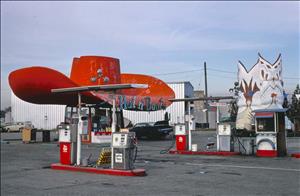On March 20, 1956, Lewis H. Nasmyth receives U.S. Patent No. 177,189 for a "new, original, and ornamental design for an article of manufacture." The article in question is the Hat ‘n’ Boots Premium Tex gas station built in 1955 at 6800 Corson Avenue S on the corner of E Marginal Way near Georgetown. The station office is canopied by a giant cowboy hat measuring 44 feet in diameter, and the restrooms are housed in boots standing 22 feet tall. The original station has nine pump islands fed by two underground 10,000-gallon fuel tanks.
Eye-catching Design
The Hat ‘n’ Boots Tex Gas Station was built to be the cornerstone attraction for the Buford Seals’ Frontier Village Shopping Complex. Seals became well known in Seattle after world War II when he and two of his Army buddies, Don Wallace and George LaMaine, launched a chain of surplus stores called the “Three GI’s” in 1946. To start this venture, they borrowed $1,700 that within 18 months turned into a $1.25-million-a-year business. Seals got out of Three GI’s in late 1948, and began laying plans for a $2 million shopping center on Corson Avenue intended to house up to 185 independent businesses with a supermarket and a gas station.
Lewis Nasmyth got to know Seals while working on cartoons and caricatures for the Three GI’s popular advertisements. Nasmyth presented the Hat ‘n’ Boots design to Seals as a conceptual drawing. Seals thought the whimsical concrete cowboy hat and boots would make a great addition to draw attention to his “Frontier Village” complex of shops and catch the eye of the motorists traveling along what was then the main highway between Seattle and Tacoma. Nasmyth carefully designed the boots “stitch by stitch and wrinkle for wrinkle in structural steel.”
Seals later explained that he and Nasmyth couldn’t find a builder to create the structure, so they themselves along with a hired helper built the hat and boots out of steel beams, chicken wire, and plaster for $150,000. Landmark records list Albert Donald Poe as architect, Gordon Construction as general contractor, and Bennett Campbell as concrete contractor, although their precise roles in the station construction are unclear. A supermarket was built on the Frontier Village site, but Seals ran out of money. None of the other shops materialized, and the market closed after just a few years.
Running Out of Gas
The Hat ‘n’ Boots Premium Tex’s opening first week matched Washington’s most successful gas station of the time, and was the state’s leader in gasoline sales for the next three years. Legend has it that Elvis pumped gas for his Cadillac at the Hat ‘n’ Boots while filming It Happened at the World’s Fair in Seattle in 1963.
Construction of Interstate 5 relegated Highway 99 to secondary status, and the Hat ‘n’ Boots lost a major portion of its gas sales. The gas station closed in 1988, when its rent exceeded its revenue. It sat derelict -- the paint fading and chipping over time. Graffiti marred its exterior and grass sprouted up through the concrete. Brave skateboarders even climbed the hat to ride its brim.
Moving the Hat 'n' Boots
In 1989, Federal Way used-car dealer Cal Worthington attempted to buy and relocate the Hat ‘n’ Boots. John Keister, of KING-TV’s comedy sketch show, “Almost Live,” also campaigned on air to salvage the station. Kai Schwartz, a Seattle architect who lives a few blocks from the Hat ‘n’ Boots, led a march in Georgetown in March 1997 by demonstrators all wearing cowboy boots and attire to protest the Hat ‘n’ Boots demolition. Schwartz’s Historic Preservation nomination application to protect the site as a Seattle Landmark was withdrawn due to technical deficiencies.
The Department of Natural Resources, which owns the property on which Hat ‘n’ Boots stands, had no objection to the landmark being preserved, but wanted it moved. The Georgetown Community Council obtained title to the structures for $1 in 2002 and secured $250,000 in grants to fund their removal to a new Oxbow Park at 6400 S Corson Avenue, and restoration at the new site.
The move was made, hat first, then boots, on December 13, 2003.

